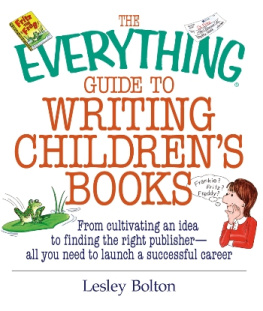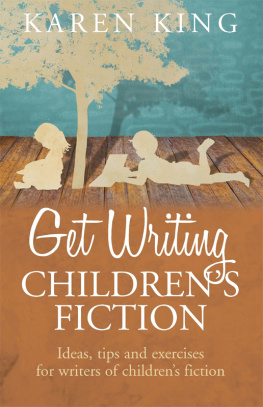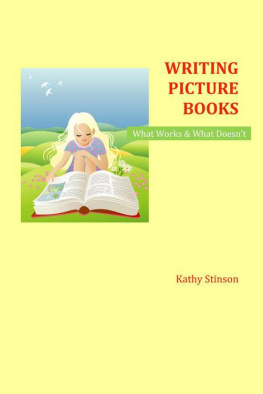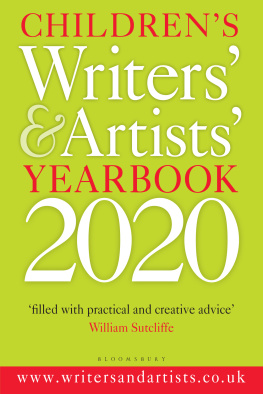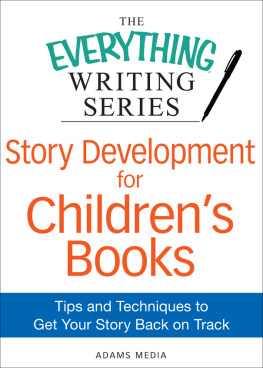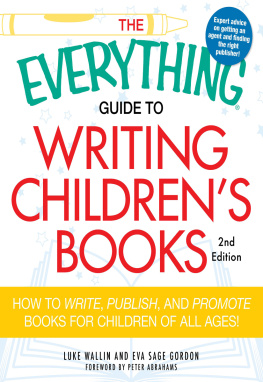
The Only Writing
Series Youll Ever Need:
Writing
Childrens Books
Lesley Bolton and Lea Wait

Adams Media
Avon, Massachusetts
Copyright 2007, F+W Media, Inc.
All rights reserved. This book, or parts thereof, may not be
reproduced in any form without permission from the publisher;
exceptions are made for brief excerpts used in published reviews.
Contains portions of material adapted and abridged from The Everything Guide to Writing
Childrens Books by Lesley Bolton, 2003 F+W Media, Inc.
Published by Adams Media,
a division of F+W Media, Inc.
57 Littlefield Street, Avon, MA 02322
www.adamsmedia.com
ISBN 10: 1-59869-088-4
ISBN 13: 978-1-59869-088-0
eISBN: 978-1-4405-1738-9
Printed in the United States of America.
J I H G F E D C
Library of Congress Cataloging-in-Publication Data
Bolton, Lesley.
The only writing series youll ever need : writing childrens books /
Lesley Bolton and Lea Wait.
p. cm.
ISBN-13: 978-1-59869-088-0
ISBN-10: 1-59869-088-4
1. Childrens literature--Authorship. I. Wait, Lea. II. Title.
PN147.5.B66 2007
808.068--dc22
2006028142
This publication is designed to provide accurate and authoritative information with regard to the subject matter covered. It is sold with the understanding that the publisher is not engaged in rendering legal, accounting, or other professional advice. If legal advice or other expert assistance is required, the services of a competent professional person should be sought.
From a Declaration of Principles jointly adopted by a Committee of the American Bar Association and a Committee of Publishers and Associations
Many of the designations used by manufacturers and sellers to distinguish their products are claimed as trademarks. Where those designations appear in this book and Adams Media was aware of a trademark claim, the designations have been printed with initial capital letters.
This book is available at quantity discounts for bulk purchases.
For information, please call 1-800-289-0963.
Contents
Middle
School
Fall
into the Market Gap
Use Your Own
Experience!
Battling
Writers Block
Revision
Checklist
Guidelines from
Publishers
Where to
Look
Tracking
Submissions
Oh, Happy
Day!
Subsidiary
Rights
Conference Displays
and Promotions
Go
the Extra Mile
Keep
Writing!
Introduction
D o you linger in the childrens book areas of libraries and bookstores? Do you imagine reading your children or grandchildren a book youve written? Do you have strong memories of books you loved as a child? Do you wish you could create those memories for new generations of children?
Youre not alone. Every year thousands of people dream of having their book for children published.
Every year some of those dreams come true.
Every year dozens of authors hold their first books in their hands, see their books in the windows of local bookstores, and proudly sign copies for their family, friends, and fans.
But few dreams come true without study, planning, and hard work. If your dream is to have your writing for children published, then youve taken the first step by picking up this book. Whether youre a beginner or youve already tried to create a picture book or a chapter book and felt discouraged and overwhelmed by all you needed to knowthis is the book for you.
I know. Just a few years ago I was an unpublished author who dreamed, too. I read hundreds of childrens books, and I read every article and book I could find about writing for children. But no book covered everything I needed to know, from studying the publishing industry, to understanding different categories of childrens books, to actually writing a book, to knowing what marketing skills would be required of me as a published author.
It took me years to learn those things. I read, I wrote, and I wrote again. And in 2001 I was one of those first-time authors who proudly held my first book in my hands. Since then Ive had three other books for children published. All four have been critically acclaimed and recommended by groups throughout the country. And Im still writing.
But it might not have taken as long for me to get my first book published if Id had a book like this one; a book that, in one volume, covers the basics of everything a writer needs to know to get his or her book for children published.
If your dream is to write for children and to have that writing published, and if youre willing to work for that dream, then keep reading. This book may be the beginning of a wonderful journey for you.
A journey that will take your writing to thousands of children who will read your books, and make your stories a part of their life.
Happy readingand happy writing! May your dreams be filled with happy endings.
Lea Wait
Chapter 1
The History and Importance
of Childrens Books
N o one can argue the importance of a child learning to read, think, and communicate, so how could anyone argue the importance of books for children? While books help a child to develop these skills, there are several other reasons that books written and designed specifically for children are important.
A Brief History of Childrens Books
Though childrens books are hot items today, this has not always been the case. We take for granted the accessibility of books. Books can be checked out for free at libraries, are prevalent in schools, and can be borrowed from friends and family. For those who want their own, books can be bought anywhere from bookstores to kiosks to grocery stores. Most important, books are readily available to children.
To truly appreciate literature for children, it helps to have an idea of the history of childrens books and the steps that were taken to make books appealing to children. However, as a writer, you first need to go even further back and study the art of storytelling through oral tradition.
Oral Tradition
Before books were available to the common person, storytelling was an oral traditionand still is in some cultures today. The art of storytelling was highly regarded (even as a profession at times), and stories were passed down to children from their parents, traveling bards, and elders of the community or tribe.
Every culture has used the story to pass on traditions and beliefs to future generations, as well as to explain the mysteries of nature, convey history, set moral standards, influence values, and simply entertain. The spoken word was powerful, and this remains true today.
Storytelling was by no means an easy task. Because the tales told had such a powerful influence and were so important to the culture, they had to be told in such a way that they would not soon be forgotten. Even stories involving war and desperation had to have an entertaining quality that would help the listener to remember so the story could be passed on to future generations. Storytellers often performed their stories and sometimes brought along drawings to help illustrate the tale. Occasionally, they would be forced to embellish or alter a common story to keep the attention of the audience.
Storytellers required a certain knack for sizing up an audience. They had to recognize the needs and wants of those listening and figure out a suitable approach. They also had to alter their techniques according to the type of audience, whether it be adults only, children only, adults and children combined, or people of a different community, town, or tribe. All these factors had to be considered before a story was told.
Next page

